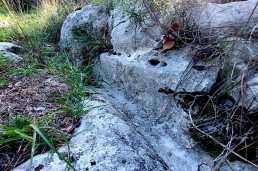Aquileia-Tergeste Road
This important road artery, described by ancient routes and identified by some scholars with the via Gemina, crossed the area between the Soča and Timavo rivers to head towards Tergeste (Trieste) and toward Pola in Istria.
From Aquileia it passed through the territory of San Canzian d'Isonzo and then in the vicinity of the villa of Staranzano; it joined other roadways near present-day Ronchi dei Legionari where a bridge over 200 meters long crossed an ancient riverbed of the Isonzo. The road then ran at the foot of the southern slope of the Monfalcone hills and continued toward Tergeste after crossing over a stone bridge over the Locavaz River. At the mouth of the Timavo was the Randaccio villa, which served as a rest station for travelers (mansio). Numerous sections of the road have been identified in the course of archaeological research and through the use of aerial photography; the discovery of funerary monuments, usually placed, in Roman times, along the road axes, has contributed to the reconstruction of the ancient road network in the area.
Bridge over the Locavaz River
The road that in Roman times led from Aquileia to Tergeste in the section east of Monfalcone ran along the coastline and crossed the Locavaz River on a bridge of which nothing remains visible today.
Alberto Puschi, director of the Trieste Civic Museum from 1884 to 1918, noted some of its elements in 1898. Speaking of the road he wrote that ... vestiges can still be seen across the marsh where it seems to lie on dam... referring to the then swamped area between the Lisert and the mouths of the Timavo River.
From his notes we know that the bridge, made of sandstone and limestone, had two arches.
The inscribed limestone block recovered in 1932 during reclamation work on theLisert marsh seems to be pertinent to it.
Membership LEG XIII mentions the 13th Gemine Legion whose soldiers would have been employed in the construction of the road and bridge or their rearrangement in the second half of the 1st century BC.




